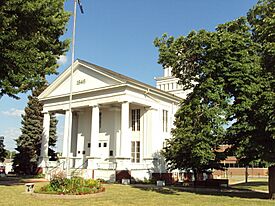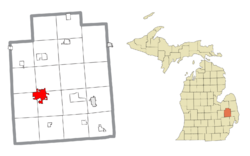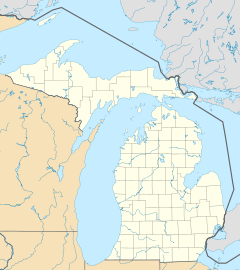Lapeer, Michigan facts for kids
Quick facts for kids
Lapeer, Michigan
|
|
|---|---|
| City of Lapeer | |

|
|

Location within Lapeer County
|
|
| Country | United States |
| State | Michigan |
| County | Lapeer |
| Settled | 1831 |
| Incorporated | 1858 (village) 1869 (city) |
| Government | |
| • Type | City commission |
| Area | |
| • Total | 7.51 sq mi (19.46 km2) |
| • Land | 7.34 sq mi (19.02 km2) |
| • Water | 0.17 sq mi (0.44 km2) |
| Elevation | 856 ft (261 m) |
| Population
(2020)
|
|
| • Total | 9,023 |
| • Density | 1,229.29/sq mi (474.63/km2) |
| Time zone | UTC-5 (Eastern (EST)) |
| • Summer (DST) | UTC-4 (EDT) |
| ZIP code |
48446
|
| Area code(s) | 810 |
| FIPS code | 26-46040 |
| GNIS feature ID | 0630146 |
Lapeer (/ləˈpɪər/ LƏ-peer) is a city in the state of Michigan, USA. It is the main city and county seat of Lapeer County. In 2020, about 9,023 people lived there.
Lapeer is located in southern Michigan, to the east of Flint. The Flint River flows through the city. Most of Lapeer was once part of Lapeer Township. Some parts were also added from Mayfield Township and Elba Township.
Contents
History of Lapeer
Early Beginnings
The land where Lapeer is now was once part of the Northwest Territory. This area was organized by the United States Congress in 1787. In 1820, the area became part of Oakland County. Later, in 1837, Lapeer County was officially formed when Michigan became a state. The first elections for county leaders happened in 1837, with 520 people voting.
How Lapeer Got Its Name
There are a few ideas about how Lapeer got its name. One story says it comes from the south branch of the Flint River. French and Native American traders often traveled through this river. They named the city after the stones found at the river's bottom. In French, "stone" is "la pierre." The English way of saying these words sounds like "Lapeer." The river itself was named Flint, which also means stone.
Another idea is that early settlers from New York State brought the name with them. A third thought is that French missionaries named the city "Le Pere," meaning "The Father."
First Settlers and Growth
The first settlers in Lapeer were Alvin N. Hart, Oliver B. Hart, and J.B. Morse. Alvin N. Hart was a very important person. He arrived in Lapeer in 1831 and planned out the Village of Lapeer in 1833. This was four years before Michigan became a state!
Alvin N. Hart later became a State Senator in 1843. He helped move the state capital from Detroit to Lansing. He passed away in 1874 and is buried in Lapeer.
Enoch J. White and his family were another group of early settlers. He came to Lapeer in 1833. Mr. White started a settlement called Whitesville, which is now the western part of Lapeer. A swamp used to separate Lapeer and Whitesville.
Important Buildings and Churches
At one time, Lapeer had two courthouses. The White family built one, and the Hart family built another. The Hart family's courthouse was bought by the local government for $3,000. It is now the oldest continuously running courthouse in Michigan. It is also one of the 10 oldest courthouses in the United States. The White family's courthouse became the first school in Lapeer, called Lapeer Academy.
Over time, businesses grew near the courthouse. In 1879, the city's founders moved the Opera House, piece by piece, to its current spot. This building is now known as the White Block.
Lapeer's first church was the Congregational Church, started in 1833. Other churches soon followed, including the Methodist Episcopal Church, Baptist Church, Immaculate Conception Catholic Church, Universalist Church, Methodist Protestant Church, and Grace Episcopal Church.
Industries and Modern Events
In the early days, lumbering was the main industry in Lapeer. The busy lumber business brought the New York Central Railroad and Grand Trunk Railroad to the city. Lapeer also became a crossing point for two state highways, M-21 and M-24.
Today, Lapeer's industries help the car industry. They make things like metal castings, plastic parts, and electrical wires. In 2010, Lapeer became a founding member of the Karegnondi Water Authority. In 2012, a winning Powerball lottery ticket worth $337 million was sold in Lapeer!
Geography and Climate
City Area
Lapeer covers about 7.38 square miles (19.11 square kilometers). About 7.13 square miles (18.47 square kilometers) is land, and 0.25 square miles (0.65 square kilometers) is water. Lapeer is part of a region in Michigan called "the Thumb," which is a subregion of the Flint/Tri-Cities area.
Weather in Lapeer
| Climate data for Lapeer WWTP, Michigan (1991–2020 normals, extremes 1949–present) | |||||||||||||
|---|---|---|---|---|---|---|---|---|---|---|---|---|---|
| Month | Jan | Feb | Mar | Apr | May | Jun | Jul | Aug | Sep | Oct | Nov | Dec | Year |
| Record high °F (°C) | 66 (19) |
68 (20) |
87 (31) |
87 (31) |
93 (34) |
100 (38) |
100 (38) |
99 (37) |
98 (37) |
89 (32) |
80 (27) |
69 (21) |
100 (38) |
| Mean daily maximum °F (°C) | 30.0 (−1.1) |
33.0 (0.6) |
43.1 (6.2) |
56.4 (13.6) |
69.0 (20.6) |
78.5 (25.8) |
82.4 (28.0) |
80.5 (26.9) |
74.0 (23.3) |
61.0 (16.1) |
47.0 (8.3) |
35.6 (2.0) |
57.5 (14.2) |
| Daily mean °F (°C) | 22.5 (−5.3) |
24.1 (−4.4) |
33.3 (0.7) |
44.9 (7.2) |
57.1 (13.9) |
66.9 (19.4) |
70.9 (21.6) |
69.1 (20.6) |
62.1 (16.7) |
50.5 (10.3) |
38.7 (3.7) |
28.9 (−1.7) |
47.4 (8.6) |
| Mean daily minimum °F (°C) | 15.1 (−9.4) |
15.2 (−9.3) |
23.4 (−4.8) |
33.5 (0.8) |
45.2 (7.3) |
55.3 (12.9) |
59.4 (15.2) |
57.7 (14.3) |
50.1 (10.1) |
40.1 (4.5) |
30.4 (−0.9) |
22.1 (−5.5) |
37.3 (2.9) |
| Record low °F (°C) | −26 (−32) |
−24 (−31) |
−17 (−27) |
4 (−16) |
23 (−5) |
31 (−1) |
36 (2) |
29 (−2) |
25 (−4) |
17 (−8) |
1 (−17) |
−15 (−26) |
−26 (−32) |
| Average precipitation inches (mm) | 2.25 (57) |
1.87 (47) |
1.91 (49) |
3.06 (78) |
3.24 (82) |
3.09 (78) |
3.33 (85) |
3.10 (79) |
2.81 (71) |
2.87 (73) |
2.42 (61) |
1.94 (49) |
31.89 (810) |
| Average snowfall inches (cm) | 10.8 (27) |
8.2 (21) |
4.8 (12) |
1.0 (2.5) |
0.0 (0.0) |
0.0 (0.0) |
0.0 (0.0) |
0.0 (0.0) |
0.0 (0.0) |
0.1 (0.25) |
1.9 (4.8) |
7.6 (19) |
34.4 (87) |
| Average precipitation days (≥ 0.01 in) | 11.5 | 9.2 | 8.3 | 10.5 | 11.1 | 9.5 | 8.6 | 9.6 | 9.0 | 10.9 | 9.9 | 10.8 | 118.9 |
| Average snowy days (≥ 0.1 in) | 7.5 | 6.3 | 2.7 | 0.8 | 0.0 | 0.0 | 0.0 | 0.0 | 0.0 | 0.1 | 0.9 | 5.6 | 23.9 |
| Source: NOAA | |||||||||||||
People of Lapeer
Population Changes Over Time
| Historical population | |||
|---|---|---|---|
| Census | Pop. | %± | |
| 1870 | 1,772 | — | |
| 1880 | 2,911 | 64.3% | |
| 1890 | 2,753 | −5.4% | |
| 1900 | 3,297 | 19.8% | |
| 1910 | 3,946 | 19.7% | |
| 1920 | 4,723 | 19.7% | |
| 1930 | 5,008 | 6.0% | |
| 1940 | 5,365 | 7.1% | |
| 1950 | 6,143 | 14.5% | |
| 1960 | 6,160 | 0.3% | |
| 1970 | 6,314 | 2.5% | |
| 1980 | 6,198 | −1.8% | |
| 1990 | 7,759 | 25.2% | |
| 2000 | 9,072 | 16.9% | |
| 2010 | 8,841 | −2.5% | |
| 2020 | 9,023 | 2.1% | |
| U.S. Decennial Census 2010 2020 |
|||
In 2020, Lapeer had 9,023 people living in 3,652 households. The city had about 1,201 people per square mile. Most residents (81.7%) were White, and 7.7% were African American. About 4.4% of the population was Hispanic or Latino.
The average age in Lapeer was 40.3 years old. About 18.3% of residents were under 18. Also, 14.3% were 65 years or older. There were slightly more males (53.6%) than females (46.4%) in the city.
Notable People from Lapeer
Many interesting people have come from Lapeer:
- Thomas Carrigan – A famous actor from silent films.
- Marguerite de Angeli – A writer and illustrator of children's books. She won the Newbery Award in 1950 for her book The Door in the Wall.
- Roger Kish – A well-known wrestler and coach.
- Terry Knight – A music producer for bands like Grand Funk Railroad.
- Jake Long – A great football player for the University of Michigan. He was the first player chosen in the NFL draft in 2008.
- Victor Prather – He set a world record for manned balloon flight in 1960. He also helped create the space suit.
- Rob Rubick – A football player who was a tight end for the Detroit Lions.
- Jim Slater – A professional hockey player for the Winnipeg Jets.
- Kris Tamulis – A professional golfer.
- Maxx Crosby – An NFL superstar and defensive end for the Las Vegas Raiders.
Getting Around Lapeer
Major Roads
 I-69 – This highway runs east and west, just south of the city.
I-69 – This highway runs east and west, just south of the city. M-24 – This highway goes north and south through Lapeer.
M-24 – This highway goes north and south through Lapeer. M-21 – This highway used to go through Lapeer. Now, it ends east of Flint after I-69 was built.
M-21 – This highway used to go through Lapeer. Now, it ends east of Flint after I-69 was built.
Trains and Buses
Amtrak is the national passenger train system. It offers train service to Lapeer. The Blue Water train runs daily. It travels between Chicago and Port Huron.
The Greater Lapeer Transportation Authority (GLTA) is the local bus system. It provides bus service within Lapeer and nearby areas.
Media in Lapeer
Radio Stations
Lapeer is part of the "Thumb" radio area. Local radio stations in Lapeer include WLCO AM, WQUS FM, and WMPC AM.
FM Stations
|
Online Media
AM Stations
|
Newspapers
- The County Press is a local newspaper published on Sundays and Wednesdays.
- The Lapeer Area View is a free local newspaper. It is mailed to homes in the county every Thursday.
- You can also find daily newspapers like the Flint Journal, Detroit Free Press, and The Detroit News in the area.
Television
Lapeer gets television channels from both the Detroit and Flint areas. Charter Communications in Lapeer offers most channels from Detroit and major channels from Flint/Tri-Cities.
See also
 In Spanish: Lapeer para niños
In Spanish: Lapeer para niños



